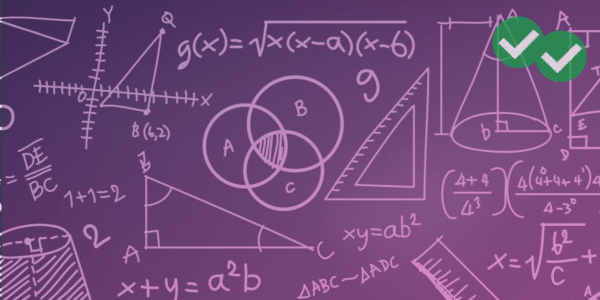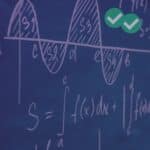
A high GRE score is often an important part of getting into your dream graduate program. For some, scoring well on the Quantitative Reasoning section (a.k.a. GRE Math) is a source of anxiety. Rest assured! You don’t need to be a mathematician to do well on the Quant section! In this post, we will outline a number of GRE math tips and resources that will help you become comfortable with the concepts and the way the GRE tests those concepts so that you are ready for whatever the test throws at you come exam day.
![]()
Get a sneak peek at Magoosh’s online GRE prep by watching the Intro to GRE Math lesson video!
Table of Contents
Quick GRE Math Tips for All Test-Takers
GRE Math Tips for Time Management
GRE Math Tips for Each Question Type
GRE Math Tips by Concept Areas
Math Tips for All GRE Test-Takers
Using (and Not Using) the Calculator on the GRE
The GRE is unique in that it is given entirely online. You are not allowed to use your own calculator. Instead, there will be a calculator provided on the computer. For more details, check out our GRE Calculator guide.
The first big piece of advice: Don’t immediately jump to the calculator for every problem! The ETS Calculator (provided on the GRE) is a bit cumbersome to use, especially if you’re used to working with a physical calculator. Rather than constantly reach for that very limited device, train yourself in mental math techniques and make good use of your scratch paper.
Second, it’s a better use of your time to think about the concepts within the problems rather than the computations involved. You’ll often find that problems are set up in a way that actually makes mental or manual calculations pretty easy or even unnecessary. If you rely on the calculator for every computation a problem requires, you are likely wasting time doing unnecessary button-pushing. Generally, you should avoid calculator use unless you’re just using it for a few. more complex, steps or when working with large values for multiplication, division, etc.
GRE Math Tips for Time Management
Pace Yourself
Pacing is key on the GRE Math section. According to ETS, “The quantitative reasoning (quant) section lasts 47 minutes. There are 2 quantitative reasoning sections. The first section takes 21 minutes to complete and consists of 12 questions. The second section is allotted 26 minutes and contains 15 questions.” So, that works out to a bit more than a minute and a half per question. If you find yourself taking more than 2 minutes on a given problem, consider moving on. The online test has a way for you to mark questions for later review.
The QR sections are also adaptive. The difficulty of the second set of questions depends on how well you did on the first set. So be very careful with the first set of questions! And don’t be discouraged if you start seeing really hard problems on the second set because that indicates that you did pretty well on the first set!
For more about leveraging your brainpower to help your pacing on GRE Math problems, check out our post on how to do GRE math faster.
GRE Math Tips for Each Question Type
Multiple Choice
![]() One great thing about single-answer multiple-choice problems is that the correct answer is sitting right there in the list of answer choices! Check out our video on when and how to use Backsolving and process of elimination to locate the correct answer.
One great thing about single-answer multiple-choice problems is that the correct answer is sitting right there in the list of answer choices! Check out our video on when and how to use Backsolving and process of elimination to locate the correct answer.
It’s also important to realize that some multiple-choice problems have multiple answers! In other words, you will be asked to mark all choices that are correct. These problems can be especially tricky and require a lot of thought.
Quantitative comparison
Quantitative Comparison questions are probably the most unique question type that you will encounter. Instead of solving for a specific value, you are asked to evaluate the relationship between mathematical expressions. Sometimes, the correct answer may even be “relationship cannot be determined!”
These problems tend to be more about concepts than computations. If there are variables, plug in a lot of different values while sticking to the restrictions of the problem. Try to think of as many cases as possible (using zero, fractions, negatives, etc..) before choosing an answer.
![]() Here are a few more resources that will help you get started: our videos on Quantitative Comparison and QC Strategies – Picking Numbers.
Here are a few more resources that will help you get started: our videos on Quantitative Comparison and QC Strategies – Picking Numbers.
Numerical entry
For this question type, you’ll have to provide the answer yourself-you cannot rely on the power of multiple choice. For these, you have to be really careful not to make arithmetic mistakes (“silly errors”), and always check your work!
To test your skills and for more tips and information check out this set of numerical entry problems.
GRE Math Tips by Concept Areas
Now that we’ve covered question formats, let’s talk about the content of the GRE Math Section.
The four main content areas are Arithmetic, Algebra, Geometry, and Data Analysis. Let’s look at each of them in more detail.
Arithmetic
Topics in Arithmetic include basic number properties, operations, estimation, percents and ratios–your basic math essentials. Be careful though! While the content is not really advanced stuff, the problems in this content area can still be quite tricky. You have to really know your numbers to succeed! Check out our GRE Arithmetic: Overview and Practice to try your hand at some practice questions.
Algebra
Algebra encompasses all the various techniques that ask you to solve for an unknown. Simplifying expressions, solving equations, factoring polynomials, and even graphing functions. You will also see questions that ask you to set up algebraic equations to solve word problems. Our GRE Algebra: Overview and Practice post goes over everything you’ll need to know regarding this topic.
Geometry
Geometry is the visual side of mathematics. You’ll need to be familiar with the properties of lines, angles, circles, triangles, quadrilaterals, and other polygons. There will be questions about area and perimeter, as well as proportional thinking in similar figures and the proper use of the Pythagorean Theorem, as well as a light sprinkling of three-dimensional figures (aka, solid geometry).
![]() To make sure you’re up to speed on key GRE geometry formulas and concepts, check out our video lessons on Geometry Strategies and Circle Properties.
To make sure you’re up to speed on key GRE geometry formulas and concepts, check out our video lessons on Geometry Strategies and Circle Properties.
Data Analysis
Topics covered under Data Analysis include basic statistics (mean, median, mode, range, etc.), as well as interpretation of data displayed in graphs, charts, and tables. Further topics delve into probability, random variables, and the normal distribution. If you are good at real-world applications of mathematics, then data analysis is your area! Whether you’re comfortable with these concepts or not, check out our GRE data interpretation practice and our post on the GRE math trick of the Dash Method to brush up your skills for this concept area.
![]() If you know that Data Analysis isn’t your forte, our video lessons on Standard Deviation, Introduction to Probability, Introduction to Counting, and Venn Diagrams can help you out.
If you know that Data Analysis isn’t your forte, our video lessons on Standard Deviation, Introduction to Probability, Introduction to Counting, and Venn Diagrams can help you out.
Conclusion
If you are certain that most of your GRE prep will focus on quantitative material, check out our advice for curating a Math-Focused GRE Study Schedule. With the right study plan in place, a positive mindset, lots (and lots) of practice, and access to the best of the best prep materials, you can get the GRE math score you need to pursue your goals!





